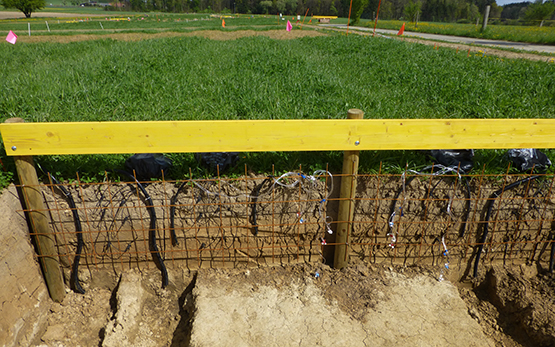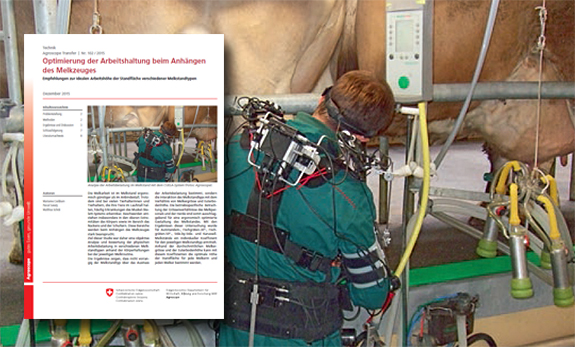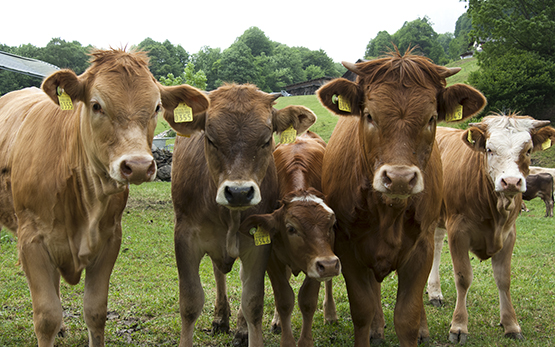Fabian Y., Roberti G., Jacot-Ammann K., Gramlich A., Benz R., Szerencsits E., Churko G., Prasuhn V., Leifeld J., Zorn A., Walter T., Herzog F.
Die Nutzung von vernässenden Ackerflächen neu denken: Synthese des Projektes «Feucht(Acker)Flächen».
Agrarforschung Schweiz, 13, 2022, 198-209.
weitere Sprachen:
französisch
Helfenstein J., Edlinger A., Herzog F.
Farmer surveys in Europe suggest that specialized, intensive farms were more likely to perceive negative impacts from COVID-19.
Agronomy for Sustainable Development, 42, 2022, Artikel 84.
Herzog F.
Agroforstwirtschaft.
In: Touch wood: Material, Architektur, Zukunft. Hrsg. Ferner C., Holdebrand T., Martinez-Carlavate C., Lars Müller Publishers. 2022, 64.
Debonne N., Bürgi M., Diogo V., Helfenstein J., Herzog F., Levers C., Mohr F., Swart R., Verburg P.
The geography of megatrends affecting European agriculture.
Global Environmental Change - Human and Policy Dimensions, 75, 2022, 1-14.
Nishizawa T., Kay S., Schuler J., Klein N., Herzog F., Aurbacher J., Zander P.
Ecological–Economic Modelling of Traditional Agroforestry to Promote Farmland Biodiversity with Cost-Effective Payments.
Sustainability, 14, (9), 2022, 1-21.
Eckerter P., Albrecht M., Bertrand C., Gobet E., Herzog F., Pfister S., Tinner W., Entling M.
Effects of temporal floral resource availability and non‑crop habitats on broad bean pollination.
Landscape Ecology, 37, 2022, 1573-1586.
Fabian Y., Herzog F., Jacot-Ammann K., Szerencsits E.
Feucht(Acker)Flächen – Keine leichte Entscheidung!
In: Nachhaltigkeitstagung 22. 27. Januar, Agroscope Reckenholz Affoltern Zürich. 2022.
Helfenstein J., Diogo V., Bürgi M., Verburg P. H., Schüpbach B., Szerencsits E., Mohr F., Siegrist M., Swart R., Herzog F.
An approach for comparing agricultural development to societal visions.
Agronomy for Sustainable Development, 42, 2022, 1-17.
Allen-Perkins A., Magrach A., Dainese M., Albrecht M., Sutter L., Herzog F., Jeanneret P., Nates Parra G., Magalhaes Pigozo C., Bartomeus I.
CropPol: A dynamic, open and global database on crop pollination.
Ecology, 103, (3), 2022, 1-8.
Bättig D., Ramseier H., Luka H., Herzog F., Jacot-Ammann K.
Blühstreifen für Bestäuber: Umfrage zeigt weitgehende Zufriedenheit in der Praxis.
Agrarforschung Schweiz, 13, 2022, 26-33.
Ammann L., Bosem-Baillod A., Eckerter P.W., Entling M.H., Albrecht M., Herzog F.
Comparing floral resource maps and land cover maps to predict predators and aphid suppression on field bean.
Landscape Ecology, 37, 2021, 431-441.
Jeanneret P., Lüscher G., Schneider M. K., Pointerau P., Herzog F., Arndorfer M., Bailey D., Balàzs K., Bàldi A., Choisis J-P., et al.
An increase in food production in Europe could dramatically affect farmland biodiversity.
Communications Earth & Environment, 2, (183), 2021, 1-8.
Nishizawa T., Kay S., Klein N., Schuler J., Zander P., Herzog F.
Integrated model-based investigation of farm management options and measures to improve biodiversity in agricultural landscapes in north-western Switzerland.
In: LANDSCAPE 2021 – Diversity for Sustainable and Resilient Agriculture, Book of Abstracts. 20–22 September, Hrsg. Leibniz Centre for Agricultural Landscape Research (ZALF), Online Conference. 2021, 173.
Hepner S., Kreuzer A., Helfenstein J., Herzog F.
Polarization of agricultural landscape across Europe?: An analysis of changing land use intensity in 14 case study sites.
In: Landscape 2021 - Diversity for Sustainable and Resilient Agriculture. 20 September, Hrsg. Leibniz-Centre for Agricultural Landscape Research (ZALF), Berlin (online). 2021, 1.
Kreuzer A., Hepner S., Herzog F., Helfenstein J.
What is the effect of increasing field size on landscape structure elements?
In: Landscape 2021 - Diversity for Sustainable and Resilient Agriculture. 21.09., Leibniz Centre for Agricultural Landscape Research (ZALF), Deutschland. 2021.
Jeanneret P., Aviron S., Alignier A., Lavigne C., Helfenstein J., Herzog F., Kay S., Petit S.
Agroecology landscapes.
Landscape Ecology, 36, 2021, 2235-2257.
Sutter L., Ganser D., Herzog F., Albrecht M.
Bestäubung von Kulturpflanzen durch Wild- und Honigbienen in der Schweiz: Bedeutung, Potential für Ertragssteigerungen und Fördermassnahmen.
Agroscope Science, 127, 2021.
Rolo V., Roces-Diaz J., Torralba M., Kay S., Fagerholm N., Aviron S., Burgess P., Crous-Duran J., Ferreiro-Dominguez N., Graves A., Hartel T., Mantzanas K., Mosquera-Losada M. R., Palma J. H., Sidiropoulou A. und weitere
Mixtures of forest and agroforestry alleviate trade-offs between ecosystem services in European rural landscapes.
Ecosystem Services, 50, 2021, 101318.
Herzog F., Nair P.
Can temperate agroforestry systems contribute to Sustainable Intensification of agriculture?
In: 5th European Agroforestry Conference - Book of Abstracts - Agroforestry for the transition towards sustainability and bioeconomy. 17-19 May, Hrsg. EURAF - European Agroforestry Federation, Italy. 2021, 150-151.
Reutimann A., Kay S., Herzog F., Naef A.
Agroforestry and climate change – can almonds be grown in northern Switzerland?
In: 5th European Agroforestry Conference - Book of Abstracts. 17-19 May, Hrsg. EURAF - European Agroforestry Federation, Online - Italy. 2021, 74-75.









